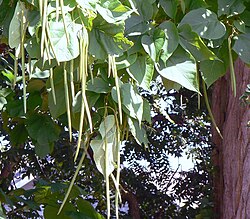*summer*,
There is nobody home but me.
Sad, really.
http://www.youtube.com/watch?v=UD-GrAMUzO8&eurl=http://www.jehovahs-witness.com/27/12364/100.ashx
JK
by JK666 15 Replies latest jw friends
*summer*,
There is nobody home but me.
Sad, really.
http://www.youtube.com/watch?v=UD-GrAMUzO8&eurl=http://www.jehovahs-witness.com/27/12364/100.ashx
JK
Catalpa trees have beautiful big heart shaped leaves, is that why you feel like one?
I like you, JK, and I like catalpas.
Is it possible to have two such unlikely "likes" in the same sentence?
CoCo Asks
I have never heard of a freakin catalpa tree!...now somebody post a pic of one of these uglies...............oompa
| Catalpa | ||||||||||||
|---|---|---|---|---|---|---|---|---|---|---|---|---|
 Catalpa speciosa flowers, leaf and bark | ||||||||||||
| Scientific classification | ||||||||||||
| ||||||||||||
| Species | ||||||||||||
11 species, including: |
Catalpa, also spelled Catawba, is a genus of mostly deciduoustrees in the flowering plant family Bignoniaceae, native to warm temperate regions of North America, the West Indies, and eastern Asia.
Catalpas grow to 10-25 m tall, and can be recognized by their large heart-shaped to three-lobed leaves, showy white or yellow flowers in broad panicles, and in the autumn by their 20-50 cm long fruits which resemble a slender bean pod, containing numerous small flat seeds, each seed having two thin wings to aid wind dispersal. Because of the leaves, they are sometimes confused for Tung trees in the south U.S.
Due to their large leaf size, Catalpas provide very dark shade and are a popular habitat for many birds, providing them good shelter from rain and wind. These trees have very little limb droppage, but they do drop large bean pods during late summer. The wood of catalpas is quite soft [1]
The two North American species, Southern Catalpa (Catalpa bignonioides), and Northern Catalpa (Catalpa speciosa) have been widely planted outside their natural ranges as ornamental trees for their showy flowers and attractive shape, or growing habit. Northern and Southern Catalpa are very similar in appearance, but the northern species has slightly larger leaves, flowers, and bean pods. Flowering starts after 275 growing degree days. The Yellow Catalpa ?? (Catalpa ovata) from China, with pale yellow flowers, is also planted outside its natural range for ornamental purposes.

The name derives from the CatawbaNative American name catawba for these trees (the tribal totem), with the spelling Catalpa being due to a transcription error on the part of the describing botanist (Scopoli) making the first formal scientific description of the genus. The rules of botanical naming state that the spelling used in the formal scientific description has to be retained for the scientific name. The name in vernacular use has very largely (though not completely) followed Scopoli's erroneous transcription, with catawba still in use in some areas of the United States, most particularly within the trees' native range.
The bean-like seed pod is the origin of the alternative vernacular names Indian Bean Tree and Cigar Tree for C. bignonioides and C. speciosa.
The tree is the food plant of the Catalpa Sphinx moth, the leaves being eaten by the caterpillars. The caterpillars are an excellent live bait for fishing, particularly in the south U.S. where some dedicated anglers plant catalpa mini-orchards for their own private source of "catawba-worms".
The Catalpa tree in Reading, UK.
The largest living Catalpa tree is on the lawn of the Michigan State Capitol, which was planted at the time the Capitol was dedicated in 1873.
The oldest is the 150-year-old specimen in the Minster graveyard of St Mary’s Butts in the UK town of Reading, Berkshire. The council have now removed the deadwood and trimmed its branches to prevent its collapse, but the trunk and tree are still alive but in poor health. A replacement tree has already been planted to pre-empt its eventual loss.
Catalpa is also occasionally used as a tonewood in guitars.
Well, let me see...
Oompa is a ship without a rudder...
Zappa is a catalpa tree...
And Simon is closing shop!
What a day!:-(